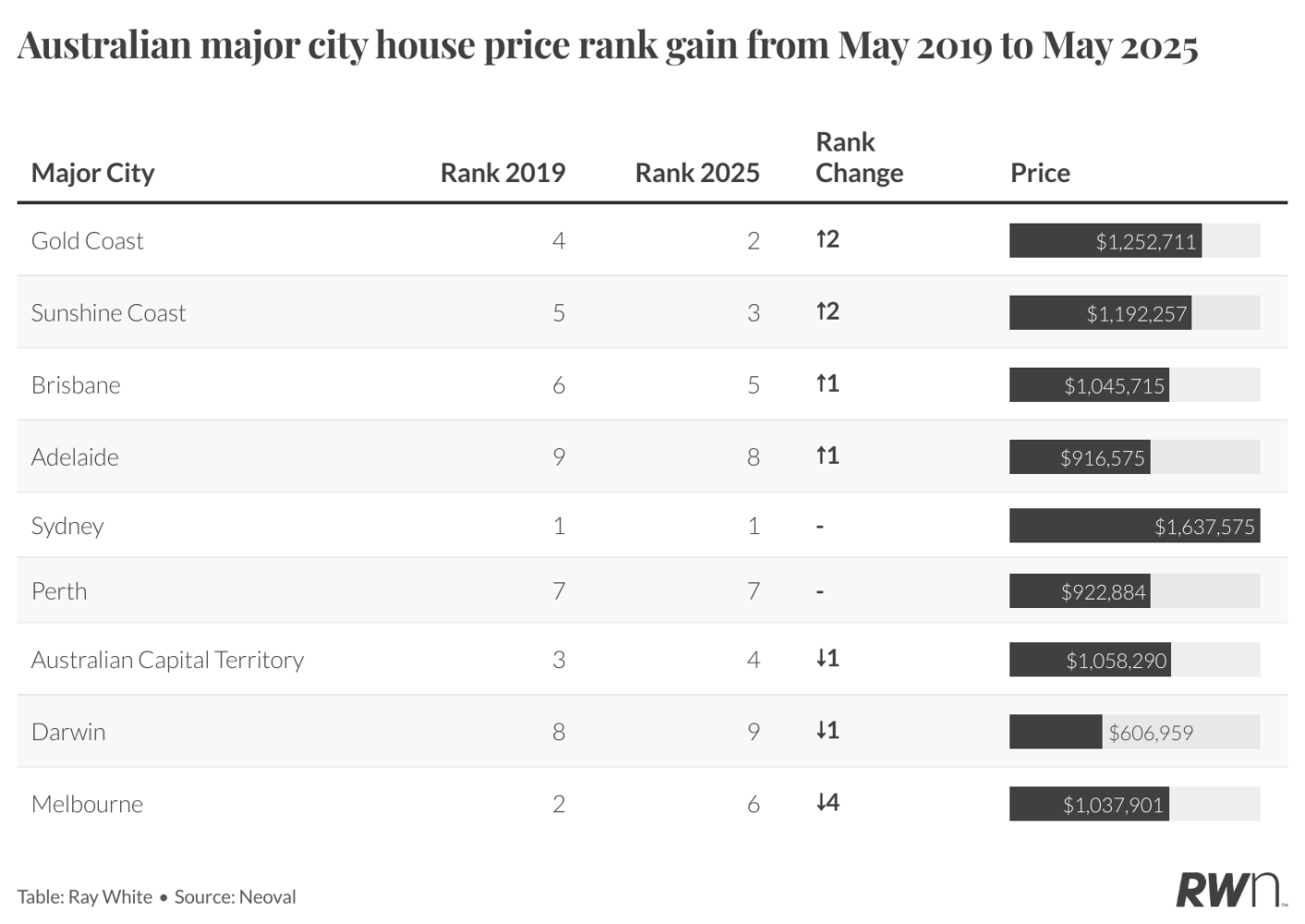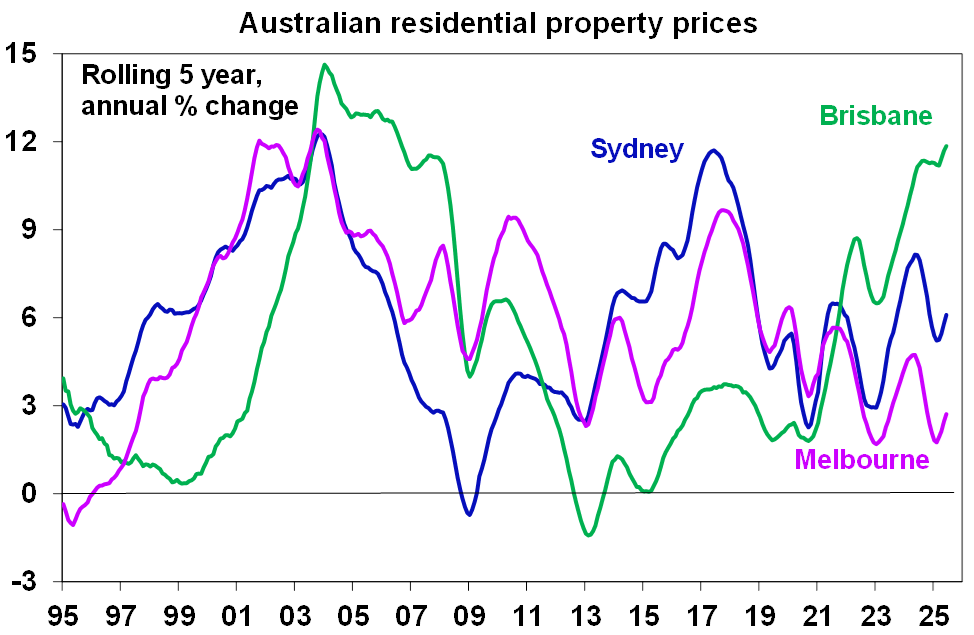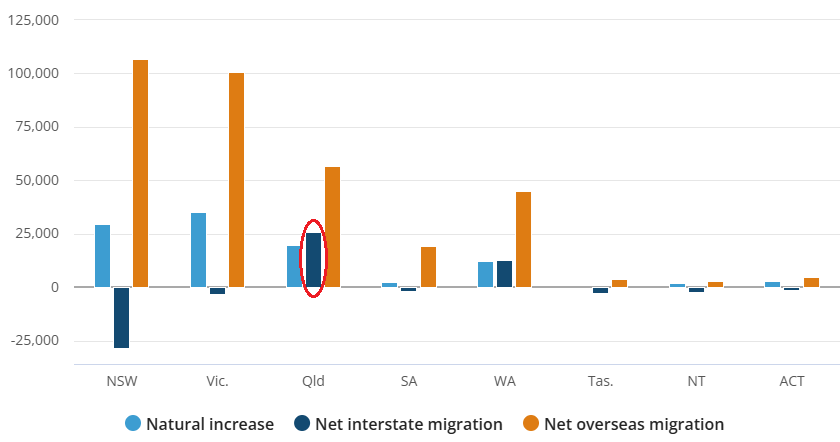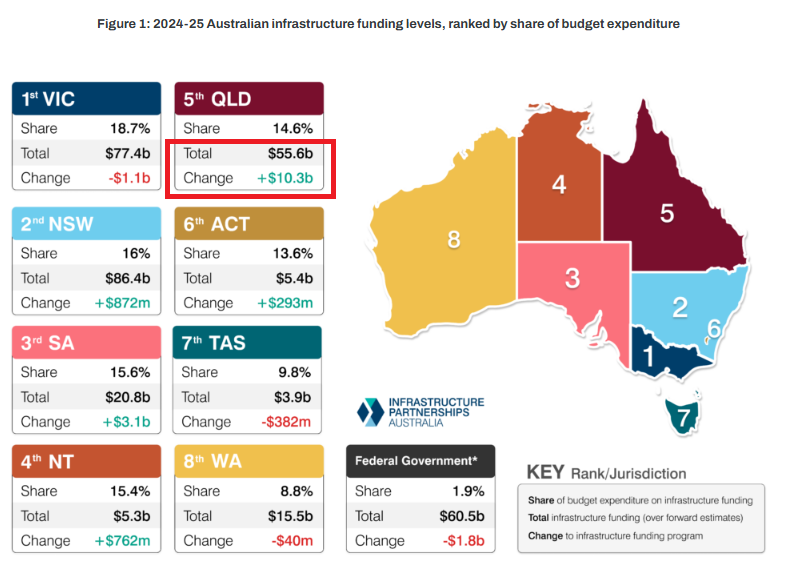How this state became Australia’s hottest property market
If you’d told me 10 years ago that Queensland’s real estate market would outperform NSW or Victoria over a sustained period, I would’ve said you were dreaming.
But that’s exactly what has unfolded over the past six years - a “complete reordering” of Australia’s property market, as Ray White Chief Economist Nerida Conisbee puts it.
The table below tells a dramatic story. Between May 2019 and May 2025, Melbourne has dropped from being the nation’s second-most expensive property market to sixth place, defying long-held assumptions that Sydney and Melbourne would always dominate the top end of the housing ladder.

Taking its place is the Gold Coast, where the median house price has surged to $1.25 million —nearly $215,000 more than Melbourne. The Sunshine Coast and Brisbane have also climbed the rankings, making Queensland the standout growth story in Australian real estate.
In this wire, I unpack the five catalysts behind Queensland’s outperformance and what it teaches investors about identifying markets with long-term potential.
1. Mean reversion meets migration
According to AMP Chief Economist Shane Oliver, Queensland’s resurgence partly reflects mean reversion after a decade of underperformance in Brisbane and South East Queensland, as shown in the graph below.
“This had left Brisbane cheap relative to Sydney and Melbourne and contributed to the recent strength as interstate migrants moved north,” he says.
.png)
COVID provided the ultimate catalyst.
Queensland has become the top destination for internal migration, particularly from New South Wales and Victoria. According to government figures, Queensland’s population grew 2.7% in the year to Q3 2023, the fastest pace in more than 15 years.
In 2024, Queensland and Western Australia were the only states to record net interstate migration gains, placing further upward pressure on housing prices in Brisbane, the Gold Coast, and the Sunshine Coast.

2. A lifestyle shift supercharged by remote work
Queensland’s subtropical climate and stunning beaches have long appealed to many of us.
But the rise of remote and hybrid work have eased - or fully removed - the geographic constraints that once kept well-paid professionals tethered to a CBD, causing an explosion in what Conisbee describes as "lifestyle-driven demand."
I’ve seen this shift play out firsthand. Two friends with young or growing families have left Sydney, trading in two-bedroom apartments for four-bedroom houses on the Sunshine Coast, all for the same price.
Queensland simply offers more bang for your housing buck.
3. From affordability to momentum
Back in 2020, the median house price in Brisbane, Gold Coast and the Sunshine Coast was below $700,000. Today, all three sit above $1 million.
Real Estate Institute of Queensland CEO Antonia Mercorella notes that the gap between Brisbane and Sydney’s median dwelling values has narrowed to just 24% - the closest margin since 2013 - compared to 42% five years ago.
Regional Queensland has been even more impressive. Since March 2020, house prices in Bundaberg and Ipswich are up 100% and 96.9%, respectively. Unit prices in Logan, Fraser Coast and Gladstone have also doubled.
“This is being fuelled by both owner-occupiers and investors seeking value and growth opportunities," she says.
4. Infrastructure and Olympic tailwinds
Queensland is experiencing a generational infrastructure boom in the lead up to the Brisbane Olympic Games. Mercorella says the Games are “building confidence in the capital and surrounds in the 2032 run up."
Projects like Cross River Rail, Brisbane Metro, and major highway upgrades are improving connectivity and liveability across South East Queensland, particularly in growth corridors such as Moreton Bay and Ipswich. These developments are likely to support continued demand over the next decade.
.png)
5. Policy divergence: Victoria’s drag
While Queensland gained ground, Victoria arguably lost its edge due to poor post-COVID economic conditions and rising taxes on property owners.
Mean reversion aside, Oliver attributes Melbourne’s underperformance to weak economic momentum and tax policies that have caused investors to flee.
“Queensland investor demand has also been boosted by more onerous taxes on investors in Victoria, seeing property investors head to Queensland,” he says.
The Victorian government’s growing debt burden - projected to reach $194 billion - has triggered a raft higher land tax rates across residential and commercial properties and annual levies on second homes and investment properties. The policy shift has weighed on prices, with house values flat year-on-year and units slipping 3%.
What is the outlook?
While price growth benefits existing owners, it presents challenges for first-time buyers. And in Queensland, the outlook isn’t encouraging, partly due to the double-whammy of overseas and interstate migrants wanting a slice of the Sunshine State.
Mercorella says construction activity isn’t keeping pace with demand, and even Premier Steven Miles - when he was in power - admitted in 2024 that “as quickly as we build it, Queensland is outgrowing it.”
“Relative affordability, lifestyle appeal, demographic shifts, low unemployment, and strong population growth are all additional factors buoying Queensland property,” says Mercorella.
But Oliver believes Queensland’s momentum has limits. If prices keep rising, affordability will eventually bite - and he expects other states to deliver stronger gains through to 2030, tipping the laggards including Melbourne to pick up steam.
“I suspect it will be Melbourne reflecting better affordability, and the other laggards of the last five or six years — Hobart, Canberra, and maybe Sydney,” Oliver says, when asked where he sees the strongest capital city growth over the next five years.
“Adelaide looks way overdone, and so does Brisbane to some degree. But momentum may keep them going for a while before poor affordability turns against them.”
1 topic
1 contributor mentioned

